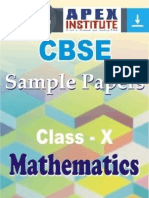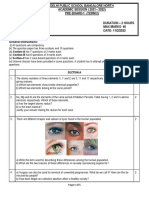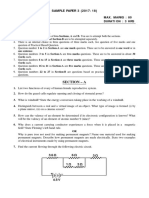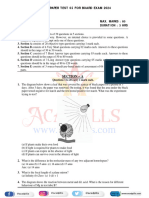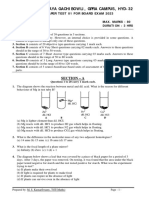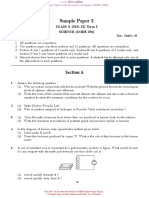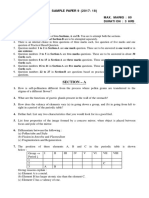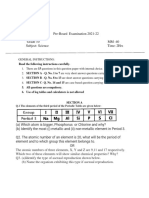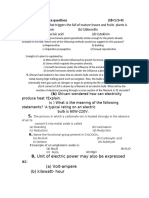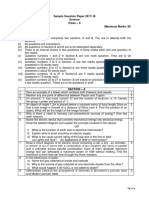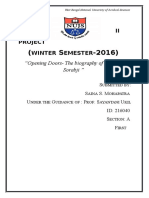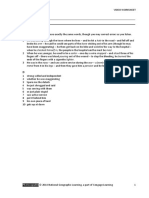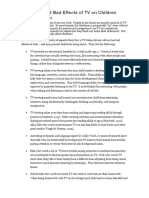Science Practice Paper
Science Practice Paper
Uploaded by
wykh64j46dCopyright:
Available Formats
Science Practice Paper
Science Practice Paper
Uploaded by
wykh64j46dOriginal Title
Copyright
Available Formats
Share this document
Did you find this document useful?
Is this content inappropriate?
Copyright:
Available Formats
Science Practice Paper
Science Practice Paper
Uploaded by
wykh64j46dCopyright:
Available Formats
CBSE Class 10 Science
Practice Paper
Term 2 Exam 2022
Max. Marks:40
Time allowed: 2 hours
General Instructions:
i) All questions are compulsory.
ii) The question paper has three sections and 15 questions. All questions are
compulsory.
iii) Section–A has 7 questions of 2 marks each; Section–B has 6 questions of 3 marks
each; and Section–C has 2 case-based questions of 4 marks each.
iv) Internal choices have been provided in some questions. A student has to attempt
only one of the alternatives in such questions.
SECTION - A
1.Study the table given below carefully and answer the questions.
(a) Which element is a nonmetal with valency 1?
(b) Which element makes only covalent bond?
(c) Which element has the largest atomic radius?
(d) Write the electronic configuration of the element C
2.How does binary fission differ from multiple fission? Give one difference between
the binary fission in amoeba and leishmania?
3.Woman had undergone surgical method for preventing unwanted pregnancies.
Does this protect her from getting sexually transmitted diseases? Write any other
two contraceptive methods.
4.Write any two limitations of Mendeleev’s periodic table and how these defects are
rectified in Modern periodic table?
5.Explain the mechanism by which the chromosome number is maintained constant
in human beings?
OR
With the help of suitable example, explain characters may be inherited, but may not
be expressed always.
6.A coil of insulated copper wire is connected to a galvanometer. What will happen if
a bar magnet is
(a) pushed into the coil?
(b) withdrawn from inside the coil?
Give reason also.
OR
Name any 2 factors on which the strength of the magnetic field produced by a
solenoid depends? How does it depend on these factors?
7.Explain with the help of an example, why the number of trophic levels in a food
chain is limited?
OR
A food chain consists of fish, larvae, phytoplankton and birds. The level of pesticides
in water in which these organisms live is high.
(a) Which organism will have the maximum amount of pesticides accumulated
through the food chain and what is this process known as?
(b) Write the food chain comprising all the organisms mentioned above.
SECTION - B
8. Calcium is an element with atomic number 20. Answer the following stating
reasons.
(a) Is calcium a metal or non-metal?
(b) Will its atomic radius be larger or smaller than that of potassium with atomic
number 19?
(c) Write the formula of its oxide.
9. What is homologous series? List its any two characteristics. Write the name and
formulae of the next higher homologue of HCOOH.
OR
What are structural isomers? Write down the possible isomers of butane.
10. Name the plant Mendel used for his experiments. What type of progeny was
obtained by Mendel in F1 and F2 generations when he crossed the tall and short
plants? Write the ratio he obtained in F2 generation plants.
11. (a) An electric bulb is rated at 200 V and 100 W. What is its resistance?
(b) Calculate the energy consumed by 3 such bulbs if they glow for 10 hours for the
month of November.
(c) Calculate the total cost if the rate is Rs 6.50 per unit.
12. Show how would you join three resistors, each of resistance 9 Ω so that the
equivalent resistance of the combination is:
(i) 13.5 Ω
(ii) 6 Ω?
Represent the above combinations in a circuit diagram.
OR
The values of current (I) flowing through a given resistor of resistance (R) for the
corresponding values of potential difference (V) across the resistor are as given
below.
(a) Plot a graph between current(I) and potential difference (V).
(b)Determine the resistance of the resistor.
13. List two main causes of the pollution of water of the river Ganga. State how
pollution of the river water proves harmful for the health of people? What steps
can be taken to solve this issue?
SECTION - C
This section has 2 case-based questions (14 and 15). Each case is followed by 3 sub-
questions (a, b and c. Parts a and b are compulsory. However, an internal choice has
been provided in part c.
14. Inheritance from one generation to the next provides a common body design
with subtle changes. While some of these differences will be unique, others will be
inherited from their respective parents who were different from each other.
Selection of variants by environmental factors forms the basis for evolutionary
processes.
(a) If a trait A exists in 10% of a population of an asexually reproducing species
and a trait B exists in 60% of the same population, which trait is likely to have
arisen earlier? (1mark)
(b) How does creation of variations in a species promote survival? (1 mark)
(c) Newly formed DNA copies may not be identical at times. Give reason (2mark)
OR
Which of the processes, sexual or asexual reproduction brings about maximum
variation in the off springs? Why?
15. A fuse is a safety device having a short length of a thin, tin-plated copper wire
having low melting point. The thickness and the length of the fuse wire depends on
the maximum current allowed through the circuit. The fuse for protecting our
domestic wiring is fitted just above our main switch on the switch board. Sangeeta of
class X used a fuse rated as 6 A in a circuit in which an electric heater
of 2.5 kW was connected with the main supply of 220 V. But the heater isn’t working.
(a) Why Sangeeta's heater is not operating? Give reason. (1 mark)
(b) Will the heater work, if the given fuse is replaced by another fuse rated 16A? (1
mark)
(c) Calculate how much current will flow in the circuit with the fuse rated 16 A? (2
mark).
Or
Write, how the fuse is connected in the circuit and why?
-----------------------
You might also like
- I Am Sharing 'CLASS 10 Pre Final 1 Feb - Converted - by - Abcdpdf' With YouDocument4 pagesI Am Sharing 'CLASS 10 Pre Final 1 Feb - Converted - by - Abcdpdf' With YoupotlurijasmithaNo ratings yet
- Kendriya Vidyalaya Gachibowli, Gpra Campus, Hyd-32: Sample Paper Test 01 For Term-2 Exam (2021-22)Document4 pagesKendriya Vidyalaya Gachibowli, Gpra Campus, Hyd-32: Sample Paper Test 01 For Term-2 Exam (2021-22)samridhiNo ratings yet
- Class - X - Science - First Preliminary Examination - QP - Set BDocument5 pagesClass - X - Science - First Preliminary Examination - QP - Set BLaksh RameshNo ratings yet
- G-X-HALF REVISION-2-SCIENCE-SET-2Document9 pagesG-X-HALF REVISION-2-SCIENCE-SET-2kpunitha.karthikNo ratings yet
- Class X Pre-Board 2021-22 SCDocument5 pagesClass X Pre-Board 2021-22 SCDAV ExaminationNo ratings yet
- Class X Pre-Board 2021-22 ScienceDocument4 pagesClass X Pre-Board 2021-22 ScienceDAV ExaminationNo ratings yet
- QP 1198Document5 pagesQP 1198anviparode07No ratings yet
- Class X Sample Paper 01 For Board Exam 2019 PDFDocument4 pagesClass X Sample Paper 01 For Board Exam 2019 PDFApex InstituteNo ratings yet
- Science Term-2 Sample PaperDocument9 pagesScience Term-2 Sample Paper[Vishal Kumar Paswan] [10 B]No ratings yet
- Science PB 1 Term 1 PaperDocument5 pagesScience PB 1 Term 1 PaperMukundan PolurNo ratings yet
- class 10 science question paperDocument9 pagesclass 10 science question papernahamed248No ratings yet
- Cbse 10th Science 2019 Paper Watermark 35Document39 pagesCbse 10th Science 2019 Paper Watermark 35Ghanshayam GuptaNo ratings yet
- Science Sample Paper1Document4 pagesScience Sample Paper1Haresh Tripathy 2No ratings yet
- Cbse Class 10 Science Important 3 Marks Questions For Term 2 ExamDocument3 pagesCbse Class 10 Science Important 3 Marks Questions For Term 2 ExamJasleen kaurNo ratings yet
- Odm Public School, Bhubaneswar: Class X Science Model Test Paper-1Document22 pagesOdm Public School, Bhubaneswar: Class X Science Model Test Paper-1adwit barunNo ratings yet
- 4 5848043971497956582 PDFDocument12 pages4 5848043971497956582 PDFHOORIYA FATIMANo ratings yet
- 10 Science 2018 Sample Paper 3 PDFDocument4 pages10 Science 2018 Sample Paper 3 PDFADITI RANJANNo ratings yet
- Sample Paper 5: CLASS X (2021-22) Term 2 Science (Code 086)Document4 pagesSample Paper 5: CLASS X (2021-22) Term 2 Science (Code 086)Sreehari.PNo ratings yet
- ST 01 - Science - C X 1Document4 pagesST 01 - Science - C X 1pratishtha MishraNo ratings yet
- Sample Paper 13: CLASS X (2021-22) Term 2 Science (Code 086)Document4 pagesSample Paper 13: CLASS X (2021-22) Term 2 Science (Code 086)PravallikaNo ratings yet
- 1730966348838_PA2_10_SCIENCE_SPDocument5 pages1730966348838_PA2_10_SCIENCE_SPalpanaprasad786No ratings yet
- Bangalore Sahodaya Schools Complex Association (Bssca) : Pre-Board Examination - Term - Ii (2021-2022) Set - 1 40Document6 pagesBangalore Sahodaya Schools Complex Association (Bssca) : Pre-Board Examination - Term - Ii (2021-2022) Set - 1 40Abhinav AtmanandNo ratings yet
- Science Sample QP 3Document4 pagesScience Sample QP 3Siddhant RSNo ratings yet
- SC 22Document8 pagesSC 22mili groupNo ratings yet
- Chennai Sahodaya Science Set 3 - QP 2022-23 - FOR EXAMDocument7 pagesChennai Sahodaya Science Set 3 - QP 2022-23 - FOR EXAMsethu ks100% (7)
- Class X Science (086) Term 2 (2021-22) Max. Marks:40 Time Allowed: 2 Hours General InstructionsDocument5 pagesClass X Science (086) Term 2 (2021-22) Max. Marks:40 Time Allowed: 2 Hours General InstructionslembdaNo ratings yet
- Class X Science (086) Term 2 (2021-22) Max. Marks:40 Time Allowed: 2 Hours General InstructionsDocument5 pagesClass X Science (086) Term 2 (2021-22) Max. Marks:40 Time Allowed: 2 Hours General InstructionsRAJASEKAR RAJAMANICKAMNo ratings yet
- Cbse Class X Science Time: 3 Hrs Total Marks: 80Document15 pagesCbse Class X Science Time: 3 Hrs Total Marks: 80Purnima SinghNo ratings yet
- Class 10 Science (02.02.2022)Document2 pagesClass 10 Science (02.02.2022)BHAVJOT KAUR SETHI0% (1)
- C.B.S.E. 2012 Sample Papers For X Science (5 Sets)Document79 pagesC.B.S.E. 2012 Sample Papers For X Science (5 Sets)Vinod Kumar0% (1)
- Sample Paper 3: CLASS X (2021-22) Term 2 Science (Code 086)Document4 pagesSample Paper 3: CLASS X (2021-22) Term 2 Science (Code 086)Ayush GargNo ratings yet
- G-X-HALF REVISION-2-SCIENCE-SET-3Document8 pagesG-X-HALF REVISION-2-SCIENCE-SET-3kpunitha.karthikNo ratings yet
- Science Class X Term 2 Sample Paper Test 07 2021 22Document4 pagesScience Class X Term 2 Sample Paper Test 07 2021 22Chirag PatilNo ratings yet
- Science Mock Paper 01 With SolutionsDocument26 pagesScience Mock Paper 01 With Solutionsrg568753No ratings yet
- Science Sample Paper Class 10 Term 2Document10 pagesScience Sample Paper Class 10 Term 2NandiniNo ratings yet
- Science Class X Sample Paper Test 01 For Board Exam 2023 1Document8 pagesScience Class X Sample Paper Test 01 For Board Exam 2023 1vro hamzaNo ratings yet
- Science QPDocument67 pagesScience QPVENKATESH YNo ratings yet
- CBSE Class 10 Science Question Paper SA1 2010Document10 pagesCBSE Class 10 Science Question Paper SA1 2010honey1002No ratings yet
- 05 Class 10 Science 2016Document5 pages05 Class 10 Science 2016manjeetsimusidanaNo ratings yet
- Document (32)Document7 pagesDocument (32)TanuNo ratings yet
- Kendriya Vidyalaya Mankhurd: Periodic Test (2021-22)Document2 pagesKendriya Vidyalaya Mankhurd: Periodic Test (2021-22)hweta173No ratings yet
- Periodic 3 10Document2 pagesPeriodic 3 10Navaya SharmaNo ratings yet
- Sample Paper 2 ScienceDocument9 pagesSample Paper 2 ScienceaswiinpkNo ratings yet
- Section-A: Sample Paper - 2009 Class - X Subject - ScienceDocument3 pagesSection-A: Sample Paper - 2009 Class - X Subject - Scienceanon-444812No ratings yet
- Class - X - Science - First Preliminary Examination - QP - Set ADocument5 pagesClass - X - Science - First Preliminary Examination - QP - Set ALaksh RameshNo ratings yet
- Jescspsu 23Document4 pagesJescspsu 23movies2023yayNo ratings yet
- Sample Paper 2: CLASS X (2021-22) Term 2 Science (Code 086)Document5 pagesSample Paper 2: CLASS X (2021-22) Term 2 Science (Code 086)Ayush GargNo ratings yet
- Podar International Scool, Latur (Cbse) : Class X Science (086) Pre-Board-1 Max. Marks: 80 Duration: 3 HoursDocument8 pagesPodar International Scool, Latur (Cbse) : Class X Science (086) Pre-Board-1 Max. Marks: 80 Duration: 3 HoursTejasvi MahuleNo ratings yet
- Grade 10 Science - QPDocument12 pagesGrade 10 Science - QPpranavv531No ratings yet
- 10 ScienceDocument4 pages10 ScienceNIpunNo ratings yet
- Scan 5 May 2022Document5 pagesScan 5 May 2022Mukul ChowdharyNo ratings yet
- Grade 10 ScienceDocument10 pagesGrade 10 ScienceshelajNo ratings yet
- 10th Science Official Sample Paper from CBSE for 2018-19Document15 pages10th Science Official Sample Paper from CBSE for 2018-19jeevasarasu151No ratings yet
- Class X Sample Paper 03 For Board Exam 2019 PDFDocument4 pagesClass X Sample Paper 03 For Board Exam 2019 PDFApex Institute100% (1)
- X ScienceDocument7 pagesX ScienceSanghamitra ChakrabortyNo ratings yet
- Ops chemistryDocument4 pagesOps chemistrysinghayoush94No ratings yet
- Science SQPDocument4 pagesScience SQPNDTV90% (61)
- Cblephpu 08Document6 pagesCblephpu 08वरदान गंजूNo ratings yet
- Shap Pak Heung Rural Committee Kung Yik She Secondary尸 SchoolDocument11 pagesShap Pak Heung Rural Committee Kung Yik She Secondary尸 Schools230033No ratings yet
- Vacuum Nanoelectronic Devices: Novel Electron Sources and ApplicationsFrom EverandVacuum Nanoelectronic Devices: Novel Electron Sources and ApplicationsNo ratings yet
- Sports Day Events ScoreDocument3 pagesSports Day Events ScoreAriel Lakatoo MingNo ratings yet
- The Natzari Yeshua Vs KairiteDocument20 pagesThe Natzari Yeshua Vs KairiteNeve NincsNo ratings yet
- Vandalur ZooDocument1 pageVandalur ZooKavi Mukilan100% (1)
- Orca 350-500GDocument58 pagesOrca 350-500GPakiNo ratings yet
- Neonatal Nurse Thesis StatementDocument8 pagesNeonatal Nurse Thesis StatementjenniferontiveroskansascityNo ratings yet
- Introduction To Sociology and Anthropology - 1Document12 pagesIntroduction To Sociology and Anthropology - 1Nafis Hasan khanNo ratings yet
- 7.soviet Union DisintegrationDocument5 pages7.soviet Union DisintegrationUsamahNo ratings yet
- Week 5 Business LoansDocument34 pagesWeek 5 Business Loans23-08439No ratings yet
- Opening Doors-Cornelia SorabjiDocument9 pagesOpening Doors-Cornelia SorabjiSaina MohapatraNo ratings yet
- CPRA X CPR NotesDocument114 pagesCPRA X CPR NotesGrace RoqueNo ratings yet
- The Promise of A Pencil: How An Ordinary Person Can Create Extraordinary Change by Adam BraunDocument16 pagesThe Promise of A Pencil: How An Ordinary Person Can Create Extraordinary Change by Adam BraunSimon and Schuster100% (1)
- Senior Citizen PWD Record Management SystemDocument32 pagesSenior Citizen PWD Record Management SystemHarvey PadillaNo ratings yet
- 2002 - Chevalier - The Cultural Construction of Domestic Space in France and Great BritainDocument11 pages2002 - Chevalier - The Cultural Construction of Domestic Space in France and Great BritainMadalena van ZellerNo ratings yet
- IBM-MBCET Note College-1Document1 pageIBM-MBCET Note College-1bajehagNo ratings yet
- S6 - Solar System 101Document18 pagesS6 - Solar System 101Raiza DioquinoNo ratings yet
- The GRI Sustainability Reporting Guidelines - Main Features ofDocument37 pagesThe GRI Sustainability Reporting Guidelines - Main Features ofdaidainaNo ratings yet
- Index Esignal Malam - One SheetDocument6 pagesIndex Esignal Malam - One SheetRidwanKrisnadiNo ratings yet
- 2011-12-20 Rothstein Scott PMDocument154 pages2011-12-20 Rothstein Scott PMmatthendleyNo ratings yet
- Answer Key: Outcomes AdvancedDocument2 pagesAnswer Key: Outcomes AdvancedSereg LeiteNo ratings yet
- The Emerging Hyperlocal Business ModelDocument4 pagesThe Emerging Hyperlocal Business ModelRahul NagrajNo ratings yet
- TreatyDocument34 pagesTreatyIcas PhilsNo ratings yet
- 2867 FullDocument5 pages2867 FullAhmad FauzanNo ratings yet
- How To Be A Better Leader Amid Volatility, Uncertainty, Complexity, and AmbiguityDocument11 pagesHow To Be A Better Leader Amid Volatility, Uncertainty, Complexity, and Ambiguityshah19suriNo ratings yet
- Test Intensiv Engleza 5Document30 pagesTest Intensiv Engleza 5Simona Singiorzan90% (30)
- R12 Answers PSYO 353Document6 pagesR12 Answers PSYO 353Matthew StewartNo ratings yet
- SubRosa Issue6 SingleDocument93 pagesSubRosa Issue6 SinglePeter SealsNo ratings yet
- Effect of TV On Children - ArticleDocument3 pagesEffect of TV On Children - ArticleMónica MeloNo ratings yet
- Product Offer For TelecommunicationsDocument84 pagesProduct Offer For TelecommunicationsisfaroNo ratings yet
- Diploma in BrewingDocument46 pagesDiploma in BrewingPin KisNo ratings yet
- Valuation Measuring and Managing The Value of Companies by Tim Koller, Marc Goedhart, David Wessels-Página883Document1 pageValuation Measuring and Managing The Value of Companies by Tim Koller, Marc Goedhart, David Wessels-Página883franzmartiniiNo ratings yet







